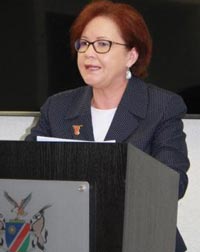
Health Ministry launches national surgical, obstetric and anaesthesia plan

The Ministry of Health and Social Services in collaboration with several parties, launched the National Surgical, Obstetric and Anaesthesia Plan (NSOAP) for Namibia 2023-2027 this week, as well as completed the Infection Prevention and Control (IPC) Action Plan and the revised guidelines for IPC, operating theatre, and Central Sterile Services Department (CSSD).
This plan, initiated by the ministry in 2018 is designed to address the challenges and shortcomings associated with surgical, obstetric, and anaesthetic services, which the ministry noted were exacerbated by COVID 19.
“This plan is more than simply a strategic document. It is a roadmap to achieving equitable access to safe and high-quality surgical, obstetric, and anaesthesia health services for all people across the country,” Dr Kalumbi Shangula, Minister of Health and Social Services, remarked at the launch this week.
He noted that his ministry engaged various stakeholders, healthcare professionals, and development partners in comprehensive consultations to develop a strategy that addresses the complexities of emergency and essential surgical conditions ranging from trauma and injury to childbirth complications and paediatric surgery.
According to the minister, the national plan encompasses six critical healthcare domains: surgical infrastructure and equipment, surgical service delivery, surgical workforce, surgical information management, surgical financing, and surgical system governance.
“We intend to strengthen our overall healthcare system, as well as to address the burden of surgical conditions. We will implement the plan in three stages, culminating in the integration of National Surgical Obstetric and Anaesthesia Plan initiatives and outcomes into our National Health Strategic Plan,” Shangula asserted.
The ministry will spend around N$1.1 billion over the next five years to cover all strategic pillars, including surgical infrastructure and equipment (N$819.1 million), surgical service delivery (N$9.7 million), surgical workforce (N$182.7 million), and surgical information management (N$88.8 million).
Meanwhile, Dr Mary Brantuo, WHO Officer in Charge of Namibia, said that the World Health Assembly (WHA) unanimously passed Resolution WHA 68.15 in 2015, emphasizing the critical role of essential surgical and anaesthesia care in achieving universal health coverage.













































